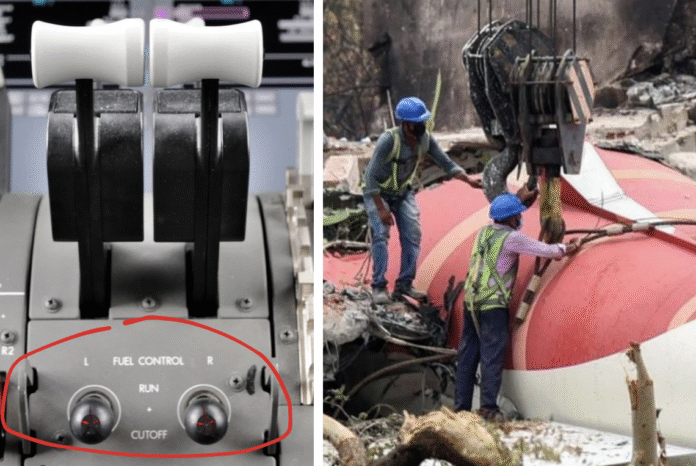Key Point Summary – Air India Crash
- 260 killed when Air India flight crashed after takeoff
- Only one passenger survived the tragedy
- Fuel cutoff switches flipped mid-air, starving both engines
- Pilots confused as one denied flipping the switch
- Black box data shows engines tried to relight before crash
- Ram Air Turbine deployed seconds before impact
- Plane slammed into a hospital hostel, killing people on the ground
One Click Doomed the Flight
A horrific crash that left 260 people dead is now believed to have been caused by a deadly mid-air mistake involving the plane’s fuel control system.
Flight AI171 had barely taken off from Ahmedabad Airport on June 12, bound for London, when disaster struck. Within seconds, both engines lost power. The plane plunged and slammed into a medical hostel—killing everyone on board except for one lone survivor, and many more on the ground.
Now, a bombshell preliminary report from India’s Aircraft Accident Investigation Bureau reveals chilling cockpit confusion and a baffling sequence of events.
Air India Crash: Switches Flipped, Engines Starved
According to flight data, just after reaching a speed of 180 knots, both fuel cutoff switches on the Boeing 787 were flipped from RUN to CUTOFF—one after the other, just a second apart.
Those two switches shut off all fuel supply to the engines.
Shockingly, the cockpit voice recorder captured one pilot asking the other, “Why did you cutoff?” The other replied, “I didn’t.”
The report doesn’t confirm who touched the switches—or whether they moved due to human error or a rare mechanical fault. But what’s clear is that both engines died just moments into flight.
Seconds From Recovery, Then It Was Too Late
After the engines died, the pilots realized the mistake and tried to switch the fuel controls back to RUN. The engines were beginning their automatic relight process when the unthinkable happened.
Seconds before regaining full thrust, the jet nosedived.
The plane crashed beyond the airport perimeter, striking the BJ Medical College hostel and turning the residential building into rubble.
The final cockpit recording included a desperate “MAYDAY MAYDAY MAYDAY.” After that, there was silence.
Voice Recorder Confirms Chaos
Investigators recovered 49 hours of flight data and two hours of cockpit audio from the black box. It showed normal pre-takeoff procedures, correct flap settings, and safe weight distribution. No birds. Or fuel contamination. No dangerous goods on board.
Everything pointed to one catastrophic moment: the cutoff switches being flipped.
Those switches sit between the pilots’ seats, guarded by a locking bar to prevent accidental movement. They must be physically moved—making accidental activation extremely rare, according to aviation experts.
Only One Walked Away Alive
The death toll climbed to 260. That included 242 passengers and crew—along with several people in the hostel struck by the falling aircraft.
Nationalities on board included 169 Indians, 53 British citizens, seven Portuguese, and one Canadian.
Only one passenger miraculously survived the impact. Their identity has not been made public, but they remain hospitalized in critical condition.
Eyewitnesses on the ground described a “fireball of metal” hurtling into the sky and slamming into the hostel’s roof.
Victims’ Families Demand Accountability
Grieving relatives wasted no time demanding answers.
Naresh Maheswari, whose son died on the flight, urged investigators to remain impartial. “We want no one else to die due to such carelessness,” he told Indian news agency ANI.
Another family member, Niraj Patel, echoed those demands. “We want the government to take every precaution so others don’t lose loved ones like we have.”
Calls for criminal charges and system-wide reform are growing louder by the day.
Pilots’ Records Under Scrutiny
The captain was an experienced 56-year-old with over 15,000 flight hours. The first officer, 32, had logged more than 3,400 hours.
Their actions—especially during those final seconds—will come under intense focus as the investigation continues.
So far, the report has not confirmed if either pilot made a procedural error or if there was a lapse in communication. But the chilling voice recording, where each denies shutting off the fuel, raises urgent concerns about possible confusion—or something far worse.
No Malfunction, No Terrorism, Just Tragedy
The aircraft’s engines were relatively new. The left engine had been installed in March, the right in May.
Fuel quality was confirmed to be normal. Flight systems appeared to work as intended. The plane’s configuration was correct for takeoff. There was no sign of bird strikes or foreign object damage.
This was not a terror attack. This wasn’t weather. This was a rare, almost unimaginable error that unfolded in under a minute.
CNN’s aviation analyst David Soucie called the accident “deeply unsettling,” saying the cutoff switches are designed not to be tripped by mistake.
Air India Responds—And Faces Backlash
Air India said it has received the report and is working closely with investigators. On X (formerly Twitter), the airline wrote:
“Air India stands in solidarity with the families and those affected by the AI171 accident. We continue to mourn the loss and are fully committed to providing support during this difficult time.”
But public frustration is rising. Aviation watchdog groups want tighter oversight of cockpit design and clearer pilot protocols. Some demand immediate retraining across India’s entire commercial fleet.
Meanwhile, politicians in India’s Parliament are already calling for hearings.
What Comes Next
Final conclusions may take months. But the stakes are high. If the investigation confirms pilot error, expect sweeping changes to training and cockpit checklists.
If it turns out to be a mechanical or electrical issue? Boeing could face a renewed storm over its Dreamliner line.
For now, the aviation world waits. But for 260 families, the answers can’t come fast enough.
They’ve buried their dead. Now they want justice—and the truth.




